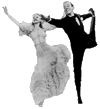 |
ROUND DANCING — CHOREOGRAPHED BALLROOMEDUCATIONAL ARTICLESMAJOR SECTIONS: Figures | Articles | Links | Alph. Index | Search | Home |
|
|
Warming Upby Harold & Meredith Sears Almost any ballroom dance manual will urge the dancer to warm up before a performance. Round dancers don’t often think in terms of “performance,” but a few minutes of stretch and warm-up can loosen and lubricate joints and tendons and reduce the risk of pulls, twists, and strains. Warm-up feels good, too. Can anyone doubt the importance of our feet and the need to take good care of them? Before we dance, let’s do 5–10 ballet releves, just to stretch and loosen up. Put your feet together, knees straight, roll onto the balls of your feet, and put pressure into the toes, heels up off the floor. Hold onto a chair back or doorjamb for balance. Lower and repeat. Next, stand on one foot and extend the other in front, foot just off the floor, and point the toes. Stretch out that ankle joint. Now bring the toes back and push the heel forward. Feel the pull in the calf. Repeat and then do the other leg.The demi- and the grand plié are two ballet movements that work on the knees and thighs. Put your heels together, toes pointed out. Keep your heels down, your knees over your toes, bend, and lower about halfway to the floor. Rise and then spring to an upright position. Do just a few and then repeat, rising onto your toes and lowering all the way to the floor. Again, rise and then spring upright. Just a few — don’t strain. Let’s try a hip tuck — put your feet together and push your hips and pelvis forward, stretching the calves and the backs of your thighs. Tighten your buttocks and your lower abs. Push into your lower abdomen and exhale. For a contra-body pull, stand with feet apart and arms loose at your sides. Slowly turn your upper body 1/4 to the right. Stretch abdominal and back muscles. Repeat and then stretch the other side. Work the shoulder joint with a big arm circle. Stand with your feet apart. Hold an arm straight out in front of you with the elbow locked and your hand in a fist. Raise your arm straight up, over, straight back behind you, down, and back up to its original position. Do some shoulder rolls. Push both shoulders forward until your back is tight and your chest is relaxed. Lift your shoulders, roll them back, down, and forward again. Roll them the other way — forward, down, back, and up. Your hands are probably least at risk, but we’re trying to loosen up the whole body and get it thinking about smooth and fluid movement. Hold your arms straight out to the side. Stretch your fingers out and apart. Reach. Relax and repeat. Finally, tilt your head to the left as though you would lay that ear down onto your shoulder. Stretch those neck muscles. Lift your head and nod forward. Put your chin on your chest. Recover and tilt toward your right shoulder. Now up and tilt your head back. Don’t roll your head around — you might grind off some little points or corners in there. Instead, come up and then tilt. Do the diagonals — up and tilt your head side and forward; up and then side and back. In dancing, we move almost every body part we have, sometimes in highly controlled and stressful ways. Warm-up tries to anticipate those moves so they don’t hit our parts with quite such a shock. Try to find other ways to move and stretch — it feels so good.
We took most of these ideas from Your “Other” Left Foot by Andy McCann. This article was published in the Washington Area Square Dancers Cooperative Association (WASCA) Calls 'n' Cues, 48-7:9, 3/2008;
reprinted North Carolina Round Dance Association
Quarterly Newsletter, October 2011;
Texas Round Dance Teachers
Association Newsletter, April 2012; Square & Round Dance Instructors Association of Alberta, January 2017.
If you would like to read other articles on dance position, technique, styling, and specific dance rhythms, you may visit the article TOC. Past DRDC Educational Articles archived here. Go beyond this site. Find other references on our Sources and Links pages.
|
 |
|
|
Page last revised